Those who endure long winters are sustained by browsing color catalogs from seed, bulb, and plant nurseries.
And gardeners who defy the cold weather resort to greenhouses or window sills crowded with amaryllis and other forced bulbs, microgreens, and foliage plants.
For those of us in hibernal denial, there’s another outlet: finding plants that actually bloom naturally in winter.
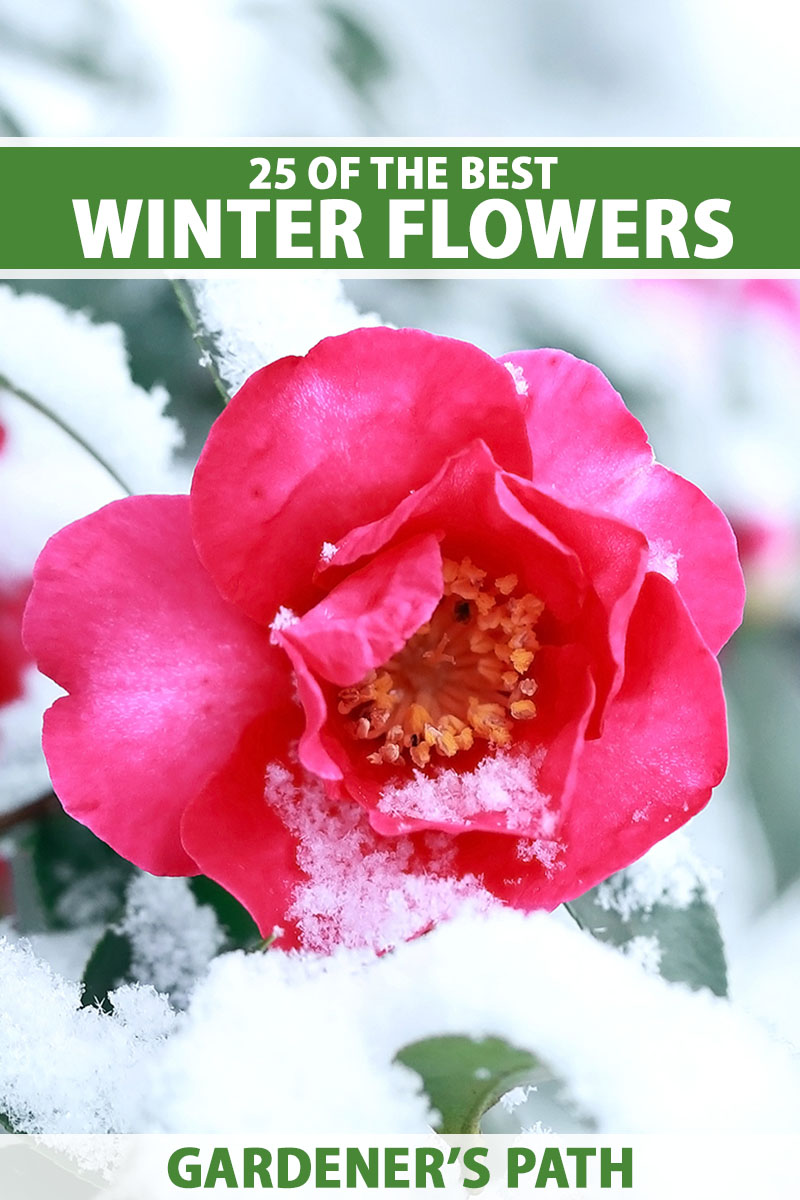
We link to vendors to help you find relevant products. If you buy from one of our links, we may earn a commission.
Some of these misfits are well known.
The Christmas rose (Helleborus niger) and the Lenten rose (H. orientalis) provide reliable winter blooms, though the former tends not to actually bloom at Christmas.
Neither is truly a rose, but rather, these species are types of hellebore.
But there are so many more options in addition to the old reliable hellebores and camellias.
Depending on your USDA Hardiness Zone, you could have a garden filled with shrubs and plants in a riot of colors throughout the winter.
Here are the plants we’ll discuss:
25 of the Best Winter Bloomers
Let’s get gardening!
1. Camellia
Not all camellias bloom in the winter, so if it’s winter color you’re looking for, you have to be alert when shopping.
Some cultivars give away the bloom time in their names. For instance, ‘Yuletide’ does indeed flower during the holidays, with bright red cheer from December through March, depending on where you live.
Speaking of, camellias are usually hardy in Zones 7 to 10, but some can even thrive in Zone 6.
Bring some ‘Yuletide’ cheer home from Nature Hills Nursery with plants available in #1 containers.
You can also tell by the bloom season designation that many growers will include on the information card.
Early and midseason bloomers will perform during winter. Late-season bloomers show off in early spring.
The US National Arboretum began a famous breeding program initiated by Dr. William Ackerman of the USDA to create extremely cold-hardy camellias after most of their C. japonica and C. sasanqua shrubs at the arboretum were wiped out during a cold winter.
The result was some modern favorites like ‘Snow Flurry,’ ‘Winter’s Charm,’ ‘Winter’s Rose,’ ‘Winter’s Hope,’ ‘Polar Ice,’ ‘Winter’s Star,’ ‘Winter’s Interlude,’ and ‘Winter’s Snowman.’
Some other awesome choices for winter color include ‘Chansonette,’ ‘Debutante,’ ‘Grace Albritton,’ ‘Jordan’s Pride,’ ‘Kramer’s Supreme,’ ‘Pearl Maxwell,’ ‘Pink Winter,’ ‘Queen of Winter,’ ‘Seafoam,’ ‘Showa-No-Sakae,’ ‘Swan Lake,’ and ‘Twilight,’ but there are hundreds of named hybrids and cultivars with a winter bloom time, so your options are vast.
It’s easy to see why some of these varieties have gained such a loyal following.
For instance, ‘Kramer’s Supreme’ has huge raspberry red blooms that start right around the holidays and stick around until your daffodils start popping up.
Fast Growing Trees carries this one if it sounds right for your space.
As a rose and peony lover, ‘Debutante’ calls my name. It has large, frilly pink double blossoms that could easily be mistaken for a peony.
It starts blooming in the fall and doesn’t quit until you see the snowdrops emerging.
Fast Growing Trees has this one available, too.
Generally, the Japanese camellia (C. japonica) and its hybrids bloom during the coldest months of the year.
Sasanqua camellias (C. sasanqua) tend to start in late summer but they might continue through the winter, depending on the cultivar and where you live.
Even when they aren’t flowering, the shrubs have gorgeous, glossy green leaves well worth having around.
Once you choose a cultivar, learn how to nurture camellias in our growing guide.
2. Crocus
Hardy crocus plants not only tolerate cold weather, they need it to bloom.
If you live in Zones 8 and up, you’ll need to stick your bulbs in the fridge to force them to emerge from dormancy. But in Zones 3 to 7, Mother Nature will do all the work for you.
Not all crocus species bloom during the winter. Saffron crocus (C. sativus), for instance, starts flowering in the fall and finishes before the cold weather comes.
Generally, winter and spring-flowering species crocuses start blooming earlier in the spring than most hybrids. They start popping up with the snowdrops.
Snow crocus (C. chrysanthus) is reliably up when the snow is still on the ground.
C. vernus ‘Jeanne d’Arc’ blooms earlier than many other vernus cultivars. The huge, snow-white petals are striped in deep violet at the base and golden yellow in the center.
Make this variety yours by visiting Eden Brothers.
Read our guide to learn how to care for crocuses.
3. Cyclamen
Many of us pop Persian cyclamen (Cyclamen persicum) into our windows for some winter cheer, but if you live in Zones 9 to 11, you can enjoy them outside.
The foliage lives on its own schedule, dying back to the ground in the winter and then popping up in the fall. By early winter, they’re showing off with solitary flowers on tall stems.
They come in many different colors, including violet, lavender, purple, pink, salmon, peach, orange, red, and white.
The heart-shaped leaves are often variegated with silver, cream, or white accents on a deep to medium green base.
Walmart carries packs of 100 seeds from Outside Pride. It’s important to keep in mind that plants grown from seed won’t bloom until their second winter.
Learn more about cyclamen in our guide.
4. Daphne
Not all daphnes are winter blooming, so don’t go running out to buy just any old thing in the Daphne genus. Look for D. odora cultivars and hybrids, commonly called winter daphne.
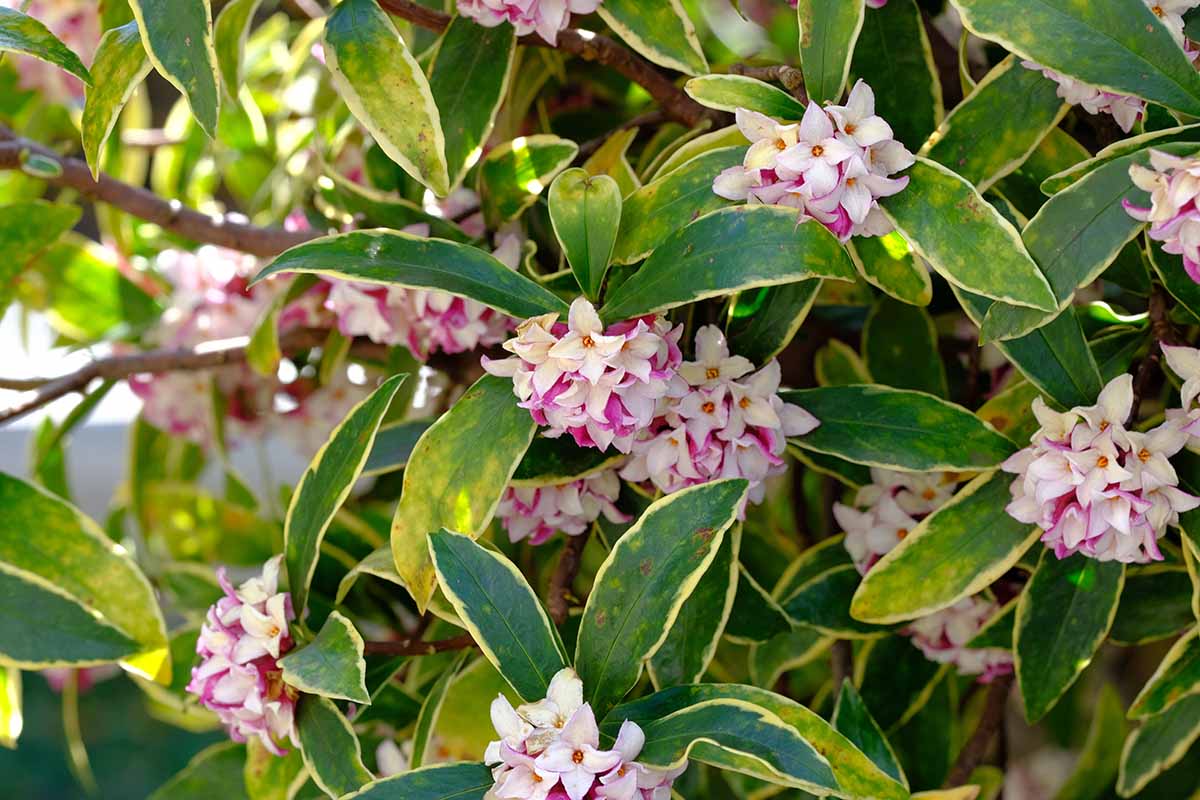
You might have guessed from the specific epithet that the flowers are heavily fragrant. Suddenly, winter is a whole different feast for the senses!
There are types with variegated leaves and others that are solid. Flowers come in white to pink or nearly red. These plants grow in Zones 7 to 9, though a few cultivars are hardy to Zone 6.
The evergreen leaves add year-round interest and the flowers persist throughout most of the cold season, from January to March, with some blooming in late spring.
Learn more about growing winter daphne in our guide.
5. Distylium
Distylium (Distylium spp.) isn’t as showy as some of the other plants on this list, but don’t write it off.
The small maroon flowers appear in clusters from January through March, highlighted against the solid or variegated green foliage.
Although plants in this genus were introduced from China, distylium isn’t invasive while still being extremely tough and adaptable.
If you are tired of boxwoods, laurels, and hollies, and want something with evergreen foliage and a compact growth habit, consider this plant instead.
I’m a particular fan of the foliage on Cast in Bronze®, which has a blue-green hue bordered in cream. You can find this option at Nature Hills in #3 containers.
Linebacker™ lives up to its name, tough and able to protect your yard from prying eyes and heavy winds. If this is the cultivar for you, Nature Hills Nursery carries it in #5 containers.
6. Dutchman’s Breeches
If the idea of late-winter flowers that look like bloomers blowing in the wind appeals to you, there’s only one plant that will fit the bill: Dutchman’s breeches (Dicentra cucullaria).
This funky spring ephemeral is native to the eastern US and returns year after year without becoming invasive.
The plant emerges in late winter and puts on a show with petite white blossoms. Once the flowers fade, the foliage does too, dying back to the ground. Don’t worry, it will be back next year.
Does this sound like another plant you know? It shouldn’t come as any surprise that Dutchman’s breeches are closely related to bleeding hearts.
Plants are available on Amazon.
7. Flowering Kale
This one is a bit of a cheat. The color doesn’t actually come from the flowers of the plant but from the colorful leaves.
This is the same species as the kale you might eat for dinner, Brassica oleracea, but these plants have been bred for their colorful leaves rather than their flavor potential.
You can technically eat them but they usually aren’t that great, with a bitter flavor.
These are annuals or biennials so you’ll have to replant them from year to year.
But in areas where they won’t be buried by the snow all winter, you can grow them for their purple, green, and white foliage.
Flowering kale can tolerate extreme cold down to 5°F, but it will bolt when the heat comes.
You can find many cultivars at nurseries, or just grab the original at Fast Growing Trees.
If you want something with primarily purple and red foliage, ‘Song Bird Red,’ available at Burpee in bundles of four plants, is an attractive option.
Learn how to grow ornamental flowering kale in our guide.
8. Glory of the Snow
Glory of the snow (Chionodoxa luciliae, formerly Scilla luciliae) is often confused with Siberian squill (S. siberica).
They’re closely related but different plants. Also known as Bossier’s or Lucile’s glory of the snow, the flowers appear in the late fall or early winter and last until early spring.
After the flowers fade, the foliage dies back. In the fall, the bulbs send out new leaves.
The blossoms are typically lavender-blue with a white center, but some cultivars might be entirely white, pink, purple, or entirely lavender-blue.
You can find bulbs available via Walmart.
9. Hellebore
If I had to rank the best bloomers to brighten up the dreary dark days, hellebores would be near the top. These herbaceous evergreen perennials have so much to offer.
We’ll start with the foliage, which is often overlooked. But I think it can be every bit as pretty in shady spots as the old reliable hosta. Plus, hellebores are evergreen!
They’re hardy enough to grow in Zones 4 to 9, and the clumps will politely spread up to two feet wide. And they even come in variegated types.
Okay, now we can talk about the flowers, which are made up of colorful sepals surrounding a nectary.
When I tell you that the sepals come in hues of green, yellow, pink, purple, and red, you might say, “yawn.”
But that’s only because that doesn’t capture the vast range of colors and patterns available here. The sepals can be double or single and can have spots, contrasting veins, or colored edges.
I mean, look at the flowers on ‘Dark and Handsome’ from the Wedding Party series.
‘Dark and Handsome’ Hellebores
The large flowers are nearly black with purple sepals lightly tinged in red. Imagine that sticking out of a thin layer of snow in your garden.
You can nab one at Burpee.
Or how about ‘Painted Bunting,’ also available from Burpee, which features single flowers with cream sepals tinged in burgundy?
I have ‘Ivory Prince’ growing in my garden.
It has single cream flowers with pink blush brushstrokes on the outer side of the sepals. This one can be found at Nature Hills Nursery.
Suddenly, the dreary dormant season isn’t looking so colorless.
I’m also a fan of ‘Fire and Ice,’ with its white petals lined in burgundy, ‘True Love,’ which is an eye-catching deep maroon and rose pink, and ‘Little Prince,’ with pinkish-copper flowers.
I could go on, but I’m going outside to enjoy my hellebores.
Learn more about growing hellebores in our guide.
10. Honeysuckle
I hear what you’re saying. “But, honeysuckle is a classic emblem of late summer!” Au contraire, my friend.
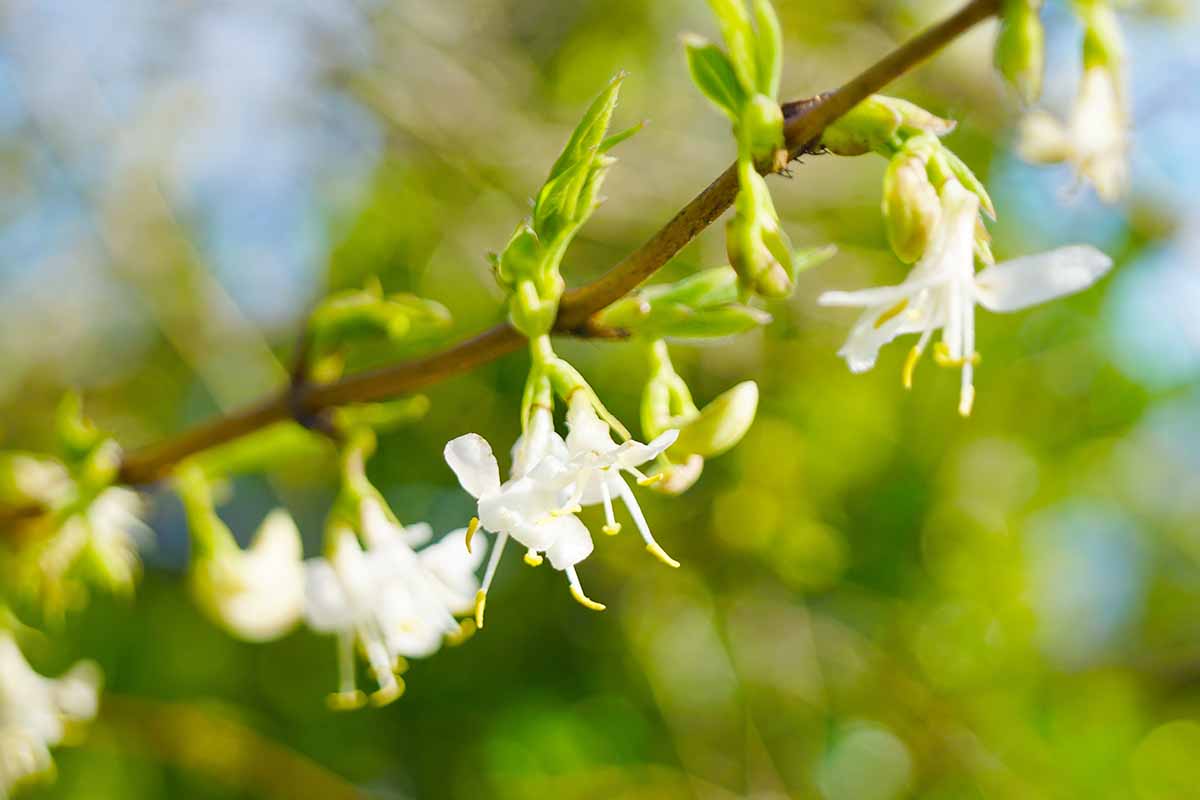
While some evergreen types will bloom at any old time of year in warm climates, intensely fragrant Lonicera fragrantissima, aka fragrant honeysuckle or January jasmine, will fill your cold days with lemon-scented yellow and white blossoms.
As nice as this option can be, note that it’s considered invasive in some areas of the southern US.
January jasmine is adaptable and hardy enough for Zones 4 to 8.
Learn more about growing honeysuckle in our guide.
11. Ipheion
Ipheions, sometimes called starflowers (Ipheion spp.), make for a pretty display when everything else is dreary and dormant.
The white to purple flowers are – wait for it – star-shaped. The plants form dense groups that emerge in early winter and bloom until the spring.

As the heat arrives, the foliage dies back and the plant goes dormant, just like daffodils and tulips. Then, just as the trees are dropping their leaves in the fall, it returns for another show.
They also make nice cut flowers, which means you can brighten up your interior as well.
12. Jasmine
Not all jasmines will breathe joy into your life during the dark days of winter, but yellow-flowered winter jasmine (Jasminum nudiflorum) and pink jasmine (J. polyanthum) will.
The first of these is hardy in Zones 6a to 10a but the second is only hardy in Zones 8a to 11a, so choose accordingly.
Admittedly, winter jasmine doesn’t have that knock-your-socks-off fragrance of its relatives, but pink jasmine does. Still, we can’t be greedy when asking for a little life during the cold months, right?
Both are evergreen vines that can use a trellis or some sort of support to make them look their best, though J. nudiflorum can be grown as a shrub.
For fragrance and color, visit Nature Hills Nursery for a live pink jasmine plant in a #5 container.
Get all the details to grow your own jasmine in our guide.
13. Mahonia
Marvelous mahonias (Mahonia aquifolium, syn. Berberis aquifolium) are shockingly adaptable.
They flower in the shade, full sun, dry spots, soggy soil, and provide food and shelter for wildlife all year long.
Some are low-growing ground covers, others reach the eaves of a one-story house.
The sour berries produced by these plants were an important food source for indigenous people, and the berries and roots are used to make dye.
Modern growers use the tight clusters of yellow flowers in winter floral displays, and the leaves make a great substitute for holly in holiday decor.
Most start blooming in late winter or early spring, followed by dark blue berries that ripen in the fall.
Does it come as a surprise that this plant, also known as Oregon grape, is the state flower of Oregon?
If you aren’t lucky enough to live in the Pacific Northwest (not that I’m biased…), you can bring a little of this native plant to your space by purchasing one at Fast Growing Trees.
Oregon grape is hardy in Zones 5 through 9.
Read more about growing Oregon Grape Holly here.
14. Pansy and Violet
Pansies and violets (Viola spp.) can provide vibrant winter color, depending on the type you grow and where you live.
Winter pansies (V. heimalis) are extremely hardy, growing in Zones 3 to 7. They can’t tolerate much heat, though, so gardeners in regions with hot summers might just grow them as annuals from fall through spring.

The flowers will be buried under heavy snow, so it’s best to grow them in a pot on a covered patio in places where deep snowfall is common.
Common pansies (Viola × wittrockiana) will bloom through the winter as well, but they aren’t quite as cold tolerant as winter pansies.
Depending on the type you pick, common pansies are hardy to Zone 6 and will keep flowering throughout the season. Again, they aren’t heat tolerant, so they will fade in many regions when the heat of summer arrives.
I have ‘Got the Blues’ growing in my front garden, and I can’t tell you how often their cheery white, yellow, and purple blossoms have boosted my mood during the dreary, endless rain of the Pacific Northwest.
If you’d like some of your own, visit Botanical Interests for a 200-milligram packet of seeds.
Violets are the same, often growing through the entire year, though they tend to fade in the summer.
Wild pansies, aka Johnny-jump-ups (Viola tricolor var. hortensis), offer a ton of color and grow in Zones 4 to 11, but they will die back and return the next season in Zones 7 and below.
Visit Fast Growing Trees to pick up some fall pansies for your garden.
Learn all about growing pansies and violets in our guide.
15. Pieris
With huge clusters of tiny little white or pink bell-shaped blossoms, Pieris japonica looks a bit like lily of the valley (Convallaria majalis), if it were a 12-foot-tall shrub that bloomed in the winter.
This broadleaf evergreen comes in solid and variegated leaf cultivars, which means it will add garden interest even when the blooms aren’t present.
Speaking of the foliage, the new leaves on Japanese andromeda, as it’s also known, are reddish-bronze until they shift to their mature color. This makes for an interesting effect.
Pieris is one of those set-it-and-forget-it plants, needing little care after you put it in the ground.
It’s a slow grower, but your patience pays off with heaps of beautiful blossoms that appear just when you’re craving them the most in Zones 5 through 9.
There are so many excellent options that you really can’t go wrong, but ‘Mountain Fire’ is awfully pretty. The foliage is red when it first emerges, and the white blossoms hang on red stems.
Head over to Planting Tree for a mounded shrub that will eventually reach eight feet tall.
16. Primrose
Primroses are all over the map. Some of them bloom in fall, some in spring, some in between, and some in all three seasons from fall to spring.
If you need color during the dreary days, you want Primula x polyantha hybrids, which are known as winter primroses. Creative name, huh?

Common primrose (P. vulgaris) isn’t what you’re looking for. This one is a summer shower.
Winter primroses come in gold, yellow, red, and blue, and shine from December through February, or even later, in Zones 8 and up.
17. Pussy Willow
Nothing says “you made it through winter!” more than pussy willows (Salix caprea). These eager trees or shrubs typically come alive in February when the snow still blankets the ground.
Once the silvery gray buds develop, they’re a favorite for cutting for home displays.
But they’re equally lovely for livening up the landscape when you’re dying for something new on the horizon.
Once the buds mature, they develop yellow flowers that add yet another layer of color and texture.
These plants grow well in Zones 3 to 7. You can find live plants in various heights available at Fast Growing Trees.
18. Siberian Squill
Siberian squill (Scilla siberica) is one of those plants that can transform the late winter and early spring garden.
It’s not native to Siberia, but rather, takes its name from the fact that it thrives in cold weather.
This perennial plant forms carpets of blue flowers with a bold floral fragrance. The floral heads will poke out of the snow year after year.
Not only do the underground bulbs spread, but the plants will seed themselves as well.
Suddenly, you’ll find your tiny little patch of color has spread into a vast carpet of joy in Zones 3 to 8. Plus, these can be had for a song.
Visit Burpee for packs of 15 bulbs.
19. Snowdrop
Every year when I start to feel like I can’t stand one more minute of winter, snowdrops (Galanthus spp.) emerge with their promise of spring.
The white bell-shaped flowers push up through the snow in Zones 3 through 8. Most do best in partial shade under the cover of an evergreen shrub or tree.
Plant bulbs in the fall and wait for the late winter show.
Burpee has packages of 25 G. elwesii bulbs available. This is one of the tallest species out there, reaching up to a foot tall.
Or go for a more petite option with G. nivalis, which tops out at about nine inches. Snag 25 bulbs from Burpee.
Learn more in our guide to growing snowdrops.
20. Spring Snowflake
Often mistaken for snowdrops, spring snowflakes (Leucojum vernum) have small, white, bell-shaped flowers. They’re related to amaryllis and bloom around the same time.
You can tell them apart from snowdrops because they’re much taller, about twice as tall.
Depending on where you live, they’ll come out right around the same time as snowdrops or just a bit after.
The foliage dies back in the summer and comes back the following year in Zones 4 to 8.
If this sounds like the right thing for your garden space, visit Walmart to bring home packets of two or five bulbs.
21. Winter Aconite
Winter aconite (Eranthis hyemalis) looks a lot like teeny tiny buttercups, and that makes sense, since it’s in the same family, Ranunculaceae.
These plants only grow six inches or so tall with clumps of yellow cup-shaped flowers starting in late winter to early spring, just before the snowdrops emerge.
The green foliage sticks around for a while after that before dying back to the ground in the summer heat. The plant emerges again once the cold weather returns.
These plants do well in Zones 4 to 7 and are happy in depleted soil like that found in rock gardens. They can also thrive in the partial shade of a woodland garden.
Have just the spot? Walmart has you covered with packages of 10 winter aconite bulbs.
22. Winter Heath
Winter heath (Erica carnea) is one of those plants that kind of blows my mind.

It can grow almost anywhere in the continental US, including most of Alaska, from Zone 2 to 10. How can one species not only thrive but blossom in so many different climates?
While the flowers themselves aren’t large, they cluster together and form a carpet of color even in the most frigid of regions. The flowers can be white, pink, or purple in a range of vibrancies.
These aren’t short-lived flowers, either. Expect them to pop up in fall and hang out until spring, though some start later in the year.

Grab a live plant with white blossoms from Green Promise Farms via Amazon.
Check out our guide to growing heathers to learn more.
23. Winterberry
Winterberry (Ilex verticillata) gives you color from fall, when the petite white blossoms form, through winter, when the bright red berries appear and persist until spring.
Closely related to the more traditional hollies like American (I. opaca) and common holly (I. aquifolium), you can see the similarities in the evergreen leaves and red berries.
You need a male plant nearby to pollinate the females for a colorful display.
I always love finding native plants that can brighten up my space, especially one that’s so adaptable it can grow anywhere in Zones 3 to 9.
‘Berry Poppins’ Winterberry Holly
I love the punny name of ‘Berry Poppins,’ and the dwarf size of this cultivar requires no pruning to keep it happy. Check out Nature Hills Nursery to bring one home in a #3 pot.
Read more about growing winterberry holly in our guide.
24. Wintersweet
Wintersweet (Chimonanthus praecox) is like a ray of sunshine during the short days of winter. It’s intensely fragrant, which earned it the nickname Japanese allspice.
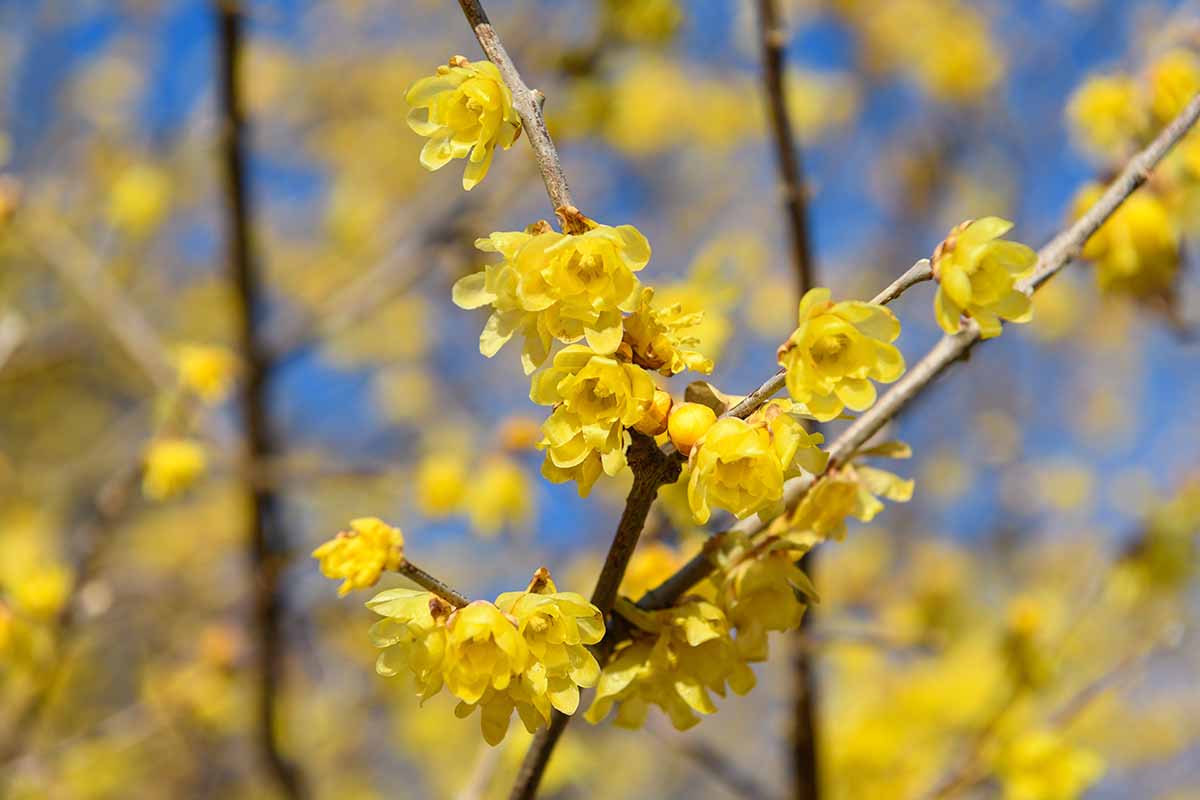
The sunny yellow blossoms pop up on bare branches during the winter in Zones 7 to 9.
Just be patient with this beauty. It can take up to a decade before it reaches its mature 12-foot height and starts blooming.
25. Witch Hazel
Until I started developing a passion for plants, I thought witch hazel (Hamamelis spp.) was some beauty product cooked up in a lab that you kept in your cupboard to use in your skincare routine.
Turns out, it’s a striking shrub or small tree that fills the garden with color while everything else is taking a nap.
And unlike certain shrubs that take up the color mantle in early spring (ahem, forsythia), it looks pretty all year long.
With its yellow, red, or purple flowers and quick growth rate, along with a brilliant fall foliage display, it’s a worthy choice for some midwinter spice.
H. virginiana ‘Little Prospect’ is ideal for those who need to fill a smaller space, as it stays within a max range of about eight feet tall and half as wide. It’s available at Nature Hills Nursery.
For something a little different, H. x intermedia ‘Diane’ will turn heads with its copper-red petals.
It’s a bit larger, at 12 feet tall and 10 feet wide. Bring this one home from Fast Growing Trees.
Learn more about this underappreciated beauty, which grows in Zones 3 to 9, in our guide to growing witch hazel.
Transform the Winter Landscape
There are plenty of options on this list to fill any garden, but don’t stop with flowers. Incorporate some evergreens for background color and texture as well.
Yews, spruces, junipers, and pines are classic landscaping trees for a good reason.
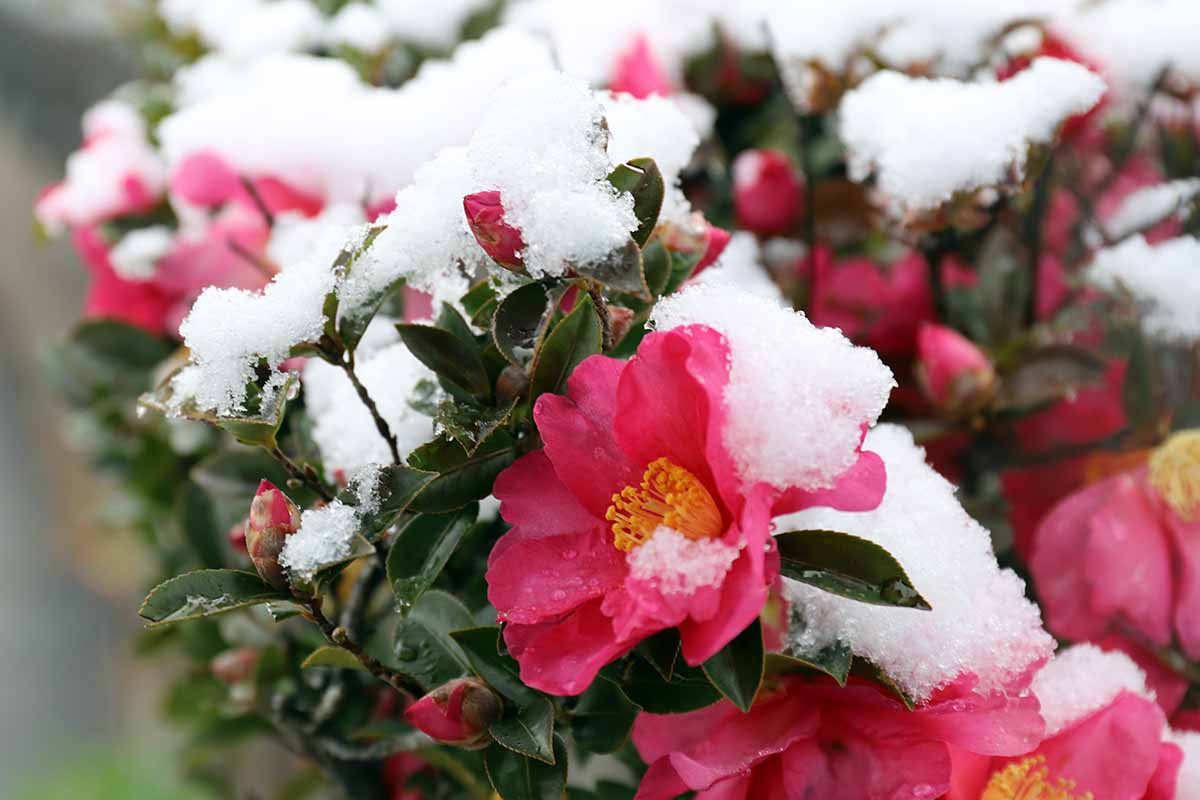
I can’t wait to hear which options you’re going to go with. Will you combine a few? Or maybe make a grouping of one type for bigger impact? Fill me in on the details in the comments.
You’ve got the winter color sorted now. And for more ideas about how to add color through the seasons, you might find these guides useful:

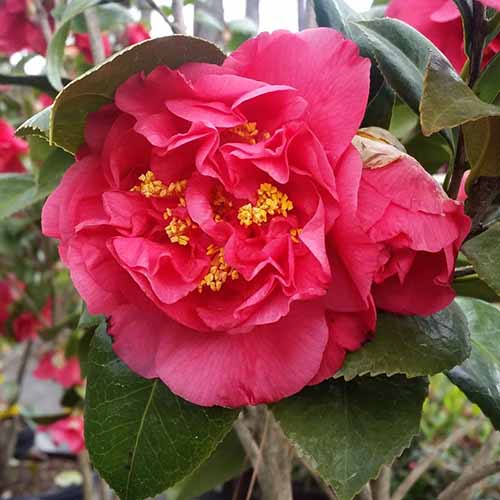
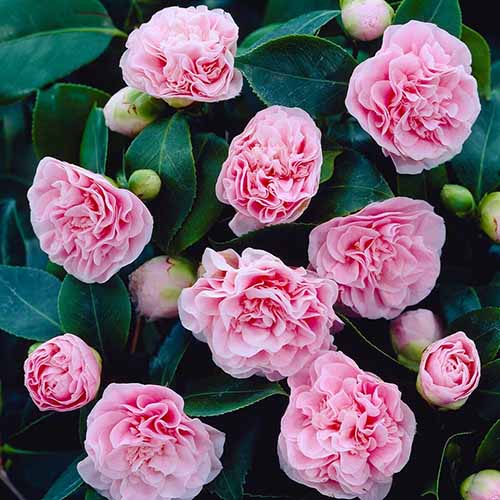
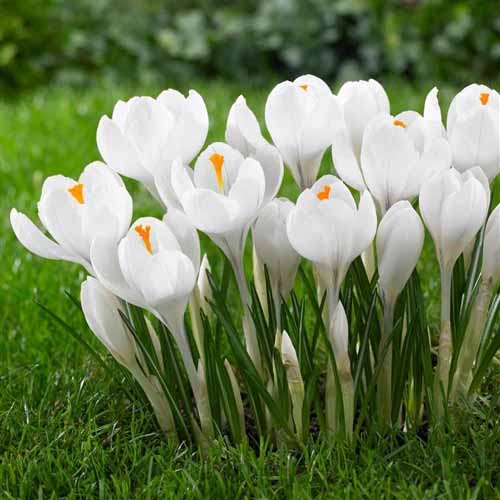
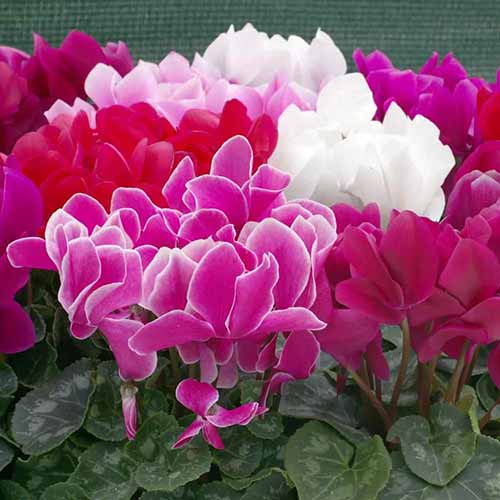
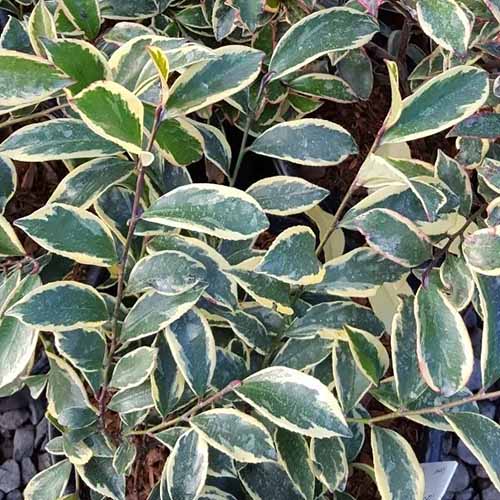
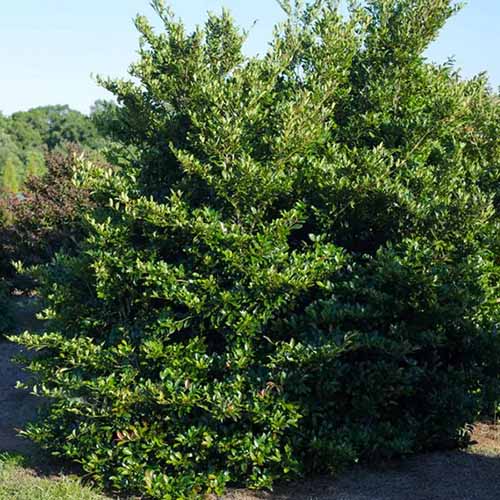
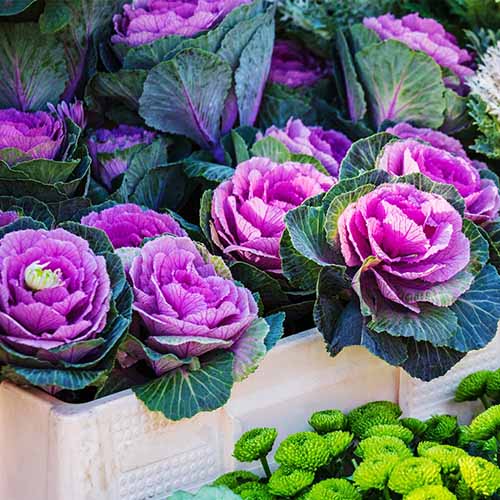

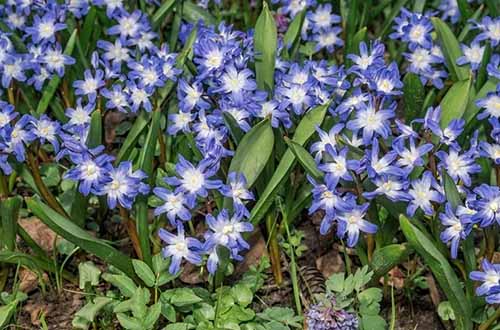
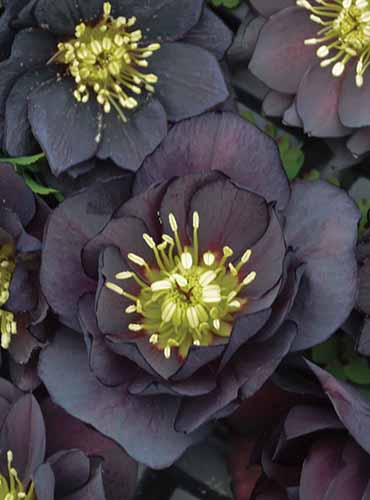
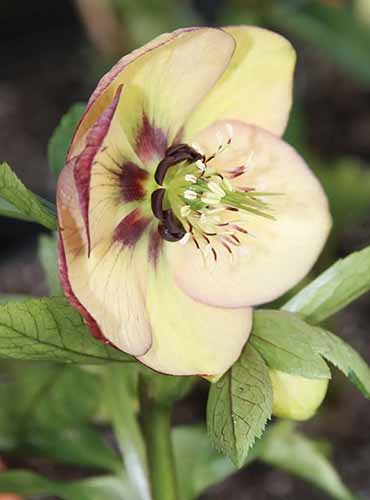
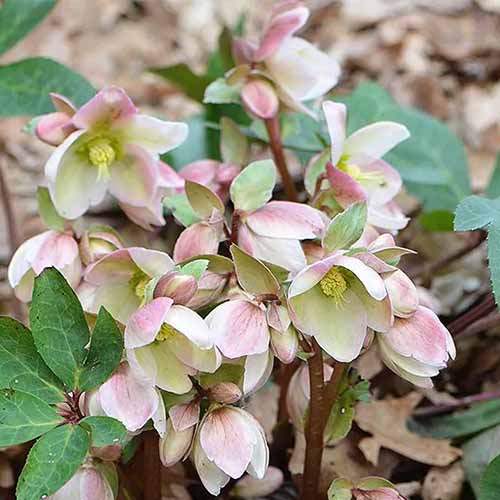
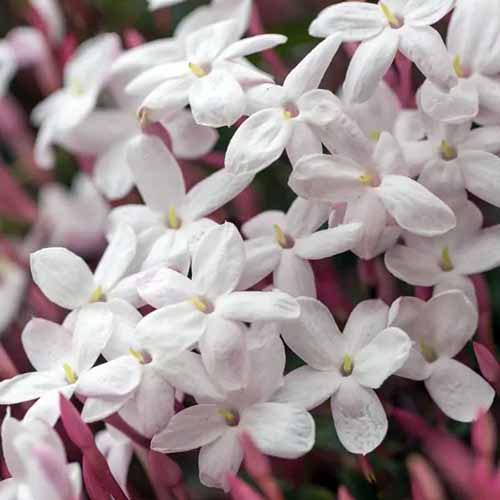
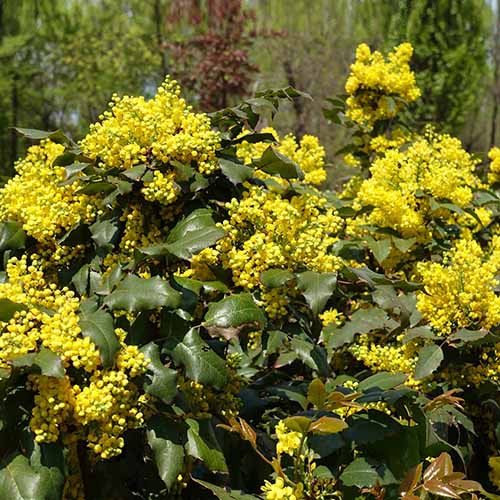

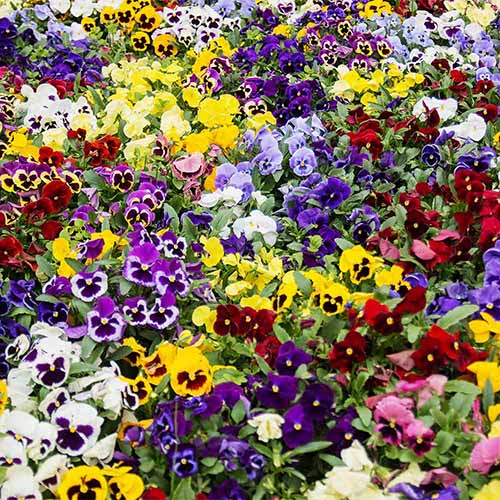
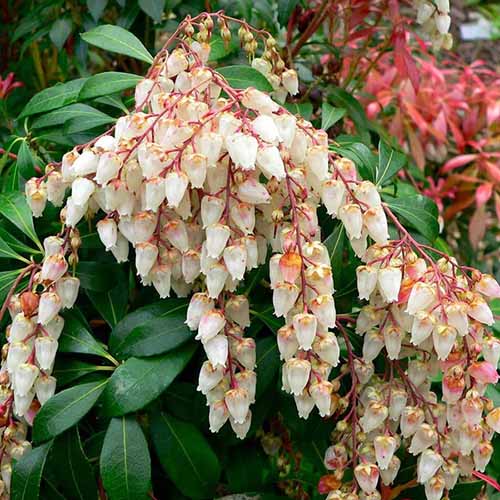
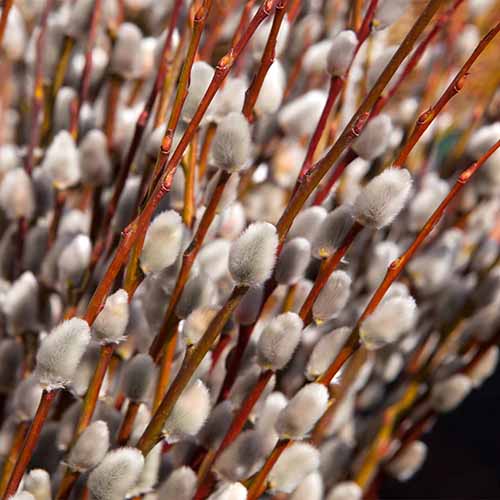

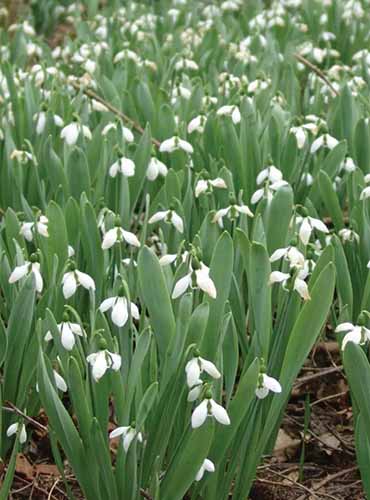
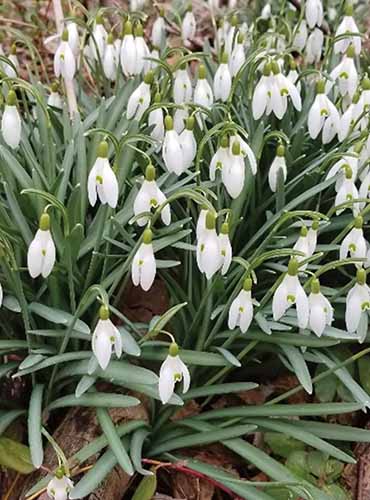

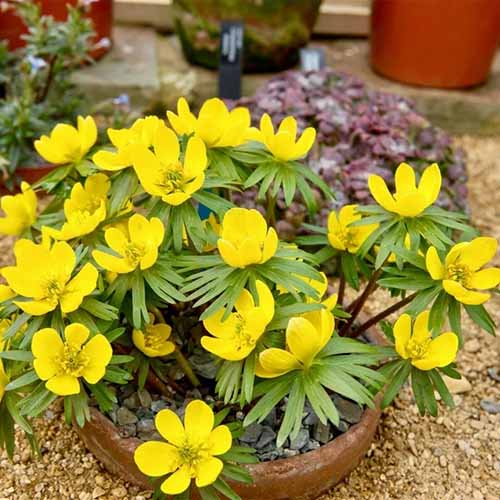
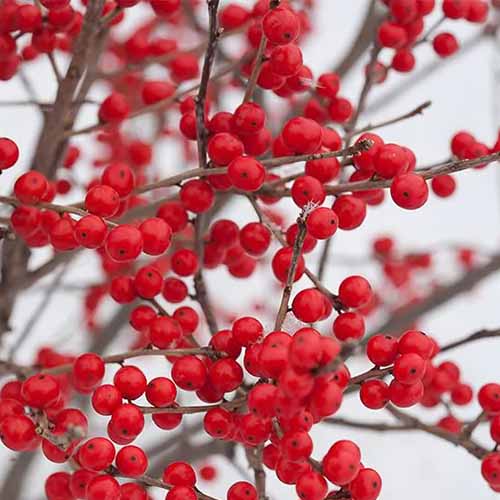

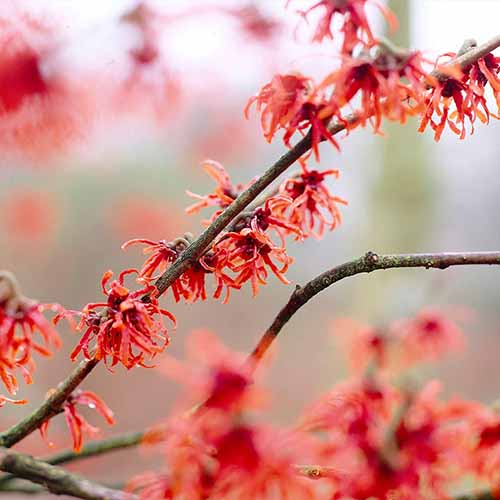
this is great!